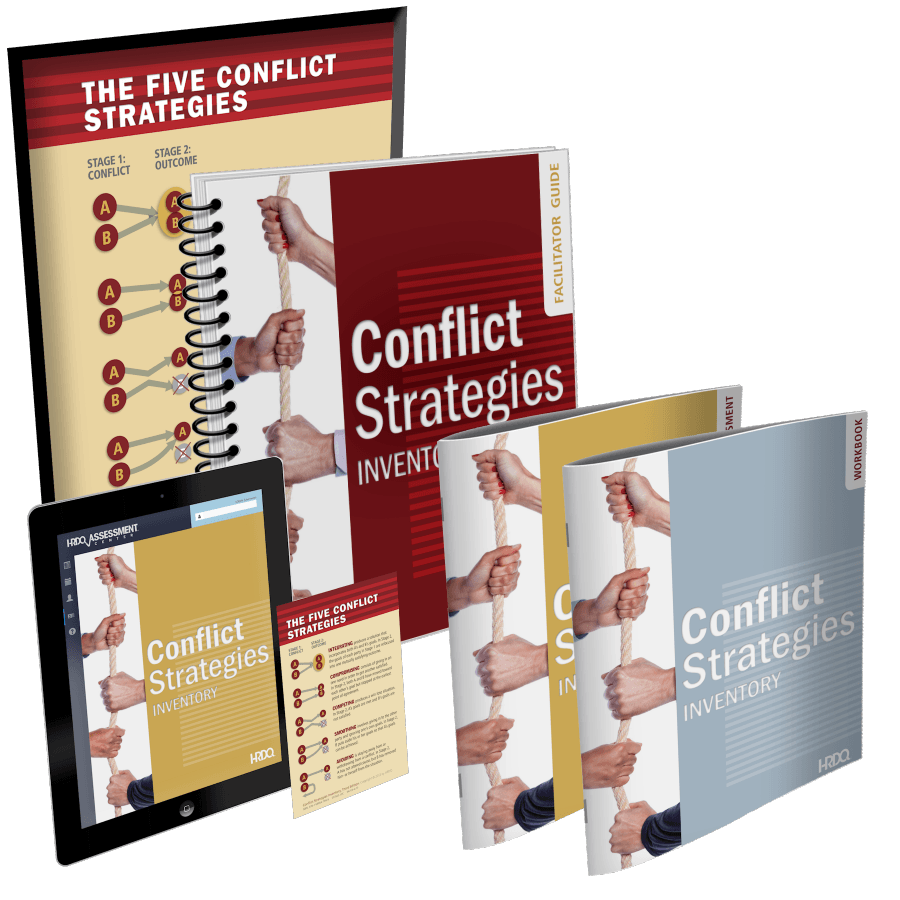Share
7 of Our Favorite Conflict Resolution Games and Activities
Bradford R. GlaserConflict resolution is a critical skill in the workplace. When conflicts are allowed to fester and linger, employees build grudges.
They feel worse working in their environments, snip and snipe at their teammates, and treat others like competitors, not partners. Morale drops, productivity drops, turnover increases, and the company culture turns toxic; if you trace it far enough, it could all have spun off from a simple quibble about a missing sandwich.
The fact of the matter is workplace conflict is costing companies real money – a shocking $350 billion is lost annually in productivity, absenteeism, turnover, and legal expenses due to conflict.
Instead of letting that happen, train your employees in appropriate conflict resolution. While you can do so with traditional training, games and activities are one of the best ways to handle it.
Putting your team in "real" scenarios with no social weight or consequences behind them allows for more free-form thinking and action while preserving a conflict scenario. Thus, you can promote appropriate means of handling conflict.

- Discover 5 ways to respond to conflict
- Explore the integrating conflict strategy
- Improve conflict responses
Table of Contents
The Benefits of Conflict Resolution Games and Activities
Using games and activities in conflict resolution offers numerous benefits that enhance both engagement and learning outcomes. Traditional training methods can be informative, but interactive elements like games create a dynamic environment where participants can actively apply new skills in real time.
Conflict resolution often involves managing emotions, understanding diverse perspectives, and reaching mutual agreements – skills that are best developed through experiential learning. The nature of games and activities also encourage collaboration, which builds trust among team members and breaks down barriers.
By turning training into a participatory experience, games and activities make conflict resolution more memorable and more effective.
Before You Begin
Before you can begin training your employees to handle conflicts amongst themselves, it's beneficial to help them understand their reactions. Different people view conflict differently and take different actions to resolve it. Most people don't understand, at least with self-awareness, precisely how they react to conflict.
In general, there are five kinds of conflict resolution styles:
- Integrating
- Compromising
- Competing
- Smoothing
- Avoiding
With these conflict-resolution strategies in play, different people will attempt to address a conflict differently. Unfortunately, these methods may conflict, so recognizing how an individual responds to conflict can build awareness and the ability to work around it.

Conflict Strategies Inventory is a self-guided test that places employees in various hypothetical scenarios and asks them to answer questions about how they react.
Each scenario's answer places them on a spectrum across these five strategies and grades them based on where they fall after the assessment is complete. Then, further training can build awareness and emphasize leveraging that conflict resolution strategy to address interpersonal and inter-team conflicts.
Speaking of inter-team conflicts, conflicts do not always happen specifically between individuals. Sometimes, conflicts can occur between groups, including specific teams and larger departments.
Additionally, the Five Dysfunctions of a Team training module is a great way to help teams learn how to recognize conflict and trace it back to its source to address it.
Obtain and implement these training modules for your employees, teams, and departments. Doing so provides a strong starting point for building conflict resolution strategies using the other games and activities on this list.
Activity 1: AITA
AITA is short for "Am I The A**hole?" It comes from Reddit, where the r/AITA subreddit is dedicated to people telling stories of conflicts and scenarios in their lives. These scenarios are presented from the poster's perspective, and the people of Reddit are asked to judge whether they were in the right or if they are, in fact, the offender in the situation.
Typically, there are three possible responses. YTA, for yes, you are. NTA, for no, you're not. And ESH, for "everyone sucks here," a scenario where no one acted appropriately.

You can use AITA-style storytelling in several ways to facilitate team training and conflict resolution:
- You can develop a story or scenario similar to what they might encounter in the workplace and roleplay it with your team. Discuss what went wrong and how the conflict could have been avoided.
- You can take real AITA scenarios and act them out with the same analysis and judgment at the end.
- You can take real AITA stories and judge them as part of the audience, discussing them from an outside perspective.
The key is to ensure that none of the scenarios you use are real scenarios from your workplace; otherwise, you risk furthering an existing conflict. Use hypotheticals and generalized stories instead.
You should also be cautious when picking actual AITA posts. Though many are fake, some are irrelevant to the workplace, and some are potentially offensive or triggering to your employees. Vet the stories you use before you use them.
Activity 2: Rotate Debates
In this scenario, you pick two employees or two teams and present an issue to them. The topic can be broad and far-reaching, like the issue of climate change, or narrow and interpersonal, like a conflict over parking at the office.
Assign each team a side for the conflict, which they will then argue for 2-3 minutes. Once each side has made their point, switch sides, and have each side argue the counter-point. Have the parties team up and argue collaboratively as an optional third phase.

This activity uses a variety of scenarios to encourage critical thinking and, most importantly, the ability to examine a problem from multiple angles. Forcing an individual or group to look at an issue from both sides allows them to see valid arguments. It promotes the ability to navigate down the middle for a solution.
Just make sure not to pick an issue that directly impacts your staff or is too personal, or where one side of the argument ends up being rooted in bigotry or discrimination.
Activity 3: Said, Heard, Meant
This conversational exercise is typically best performed by two individuals, and any two individuals can partake. Here's how it works.
The first speaker begins with a statement. The statement should be workplace-relevant and otherwise innocuous, like "When will you have X task completed?"
The second speaker interprets this statement uncharitably, as they might if they're looking for subtext. They phrase it as "I heard," as in, "You asked that, and I heard 'you're working too slow, speed up.'"
The first speaker refutes this with an "I meant" statement. As in, "You heard 'you're working too slow,' but I meant 'I need to know a timeline so I can plan the rest of my day.'"

This chain can end after discovering the underlying meaning and discussing the disconnect between what one party means and what another hears. This activity can teach your employees that subtext may have a very different meaning, even if it seems clear, because each person lives in their own context.
The activity aims to promote clearer, more forthright communication to avoid conflicts based on misinterpretation. Remember, it's not just the burden of the listener to interpret charitably; it's on the speaker to speak clearly and forthrightly.
Activity 4: The Two Dollar Game
In this game, developed at MIT, players focus on hidden motives, differing objectives in negotiation, and the conflicts that arise from individuals operating with their own interests in mind.

For this game, employees are paired off into groups of two. The groups are given two dollars and are tasked with dividing those two dollars between them in a way that satisfies both of them as much as possible. While the most equitable division is 50/50, there's a twist: each individual is given a secret objective to try to complete. Objectives can include:
- Want to take home as much as possible over the $1 half.
- Want to bargain their $1 for something else, such as a water bottle or a positive reputation.
- Want to "give" their $1 out in exchange for a promise of a favor later.
A full rundown of this conflict game and the various objectives it can teach you can be found here.
Activity 5: Arm Wrestling
This game is challenging because it requires that no one actually say arm wrestling. Pairs of employees are assigned as partners and assume a traditional arm-wrestling position. They are given two instructions:
- You earn a point if the back of your partner's hand touches the table.
- You want as many points as possible and don't care about anyone else.
Then, give the pair ten seconds (or however long you want the activity to last) to figure out how to earn as many points as possible.

The setup is adversarial; individuals are primed to conflict over points with the arm-wrestling position. However, assumptions are made that are never stated. Such as:
- No one said you couldn't let go of each other's hands and tap on your own.
- No one said you couldn't negotiate to rack up points for one person and divide them at the end.
- No one said you can't talk to one another (if they did not communicate).
You can read more about this exercise and the debrief here.
Activity 6: Storytelling
For this activity, your team gets together to tell stories about actual, real conflicts they've been involved with in the past. Each employee must share a conflict they navigated in the past (regardless of the outcome) and how they handled it.
This exercise aims to demonstrate that everyone has had times when they've been wrong or unreasonable and how they've handled conflict in the real world. The employee tells their story, and the team can discuss it, offer criticism and suggestions, and discuss an appropriate resolution.

Be cautious here about the stories each individual chooses. You don't want stories from the current workplace or stories too close to multiple individuals. You also want to avoid ongoing conflicts or stories involving anything too personal or risky to disclose. This activity is, after all, a very personal exercise.
Activity 7: Knot or Not
This simple activity requires one prop: a colorful, distracting rope. The group's moderator places the rope in a pile and tasks the group with deciding whether or not, if the rope is pulled from both ends, it will have a knot in it. There's more to it, though.

Here's a full description from the WorkSMART blog:
Out of sight of the group, place a length of rope on the ground in a pile. My rope is about 20′ long. I use a two-colored rope to make it a little more difficult. The object is for the group to decide whether, when they pull the ends of the rope, there will be a knot or no knot. Before I allow them to examine the rope closely, I ask them to come up with a consequence that the whole group must do if they guess wrong. Also, the decision of the group must be unanimous. Then the fun begins. Usually, one or more have a strong opinion one way or the other. Those are the ones I focus on. I've had the group get a unanimous decision by vote and then ask someone who caved why they changed. If questioned, I have had the entire group turn their decision around. I will also ask the person who went against their strong opinion what they would do if I made them the group leader and their decision was the final one.
I can tell you from experience that they will pick an easy consequence, so once they have come to a unanimous decision, I will ask the ones who gave in how difficult the consequence would have had to have been for them to stand their ground. Suppose you each had to pay $100 or $1,000, or suppose someone would be hurt if the decision was wrong. There is a lot you can do with this, but it's a very telling exercise when it comes to conflict resolution.
This exercise tasks a group with coming to a decision and then questions the people responsible for making the decision unanimously why they went the way they did, and what the stakes would need to be for them to stand firm.
Resolving Conflict
Conflict is inevitable in a world where individuals must interact with one another, both in and out of an organization or a business context. Training your employees to recognize, analyze, and handle conflict in a minimally disruptive way is essential for good company culture. The activities and assessments above all help do this in various ways. The question is, which ones will work the best for your organization?

Get Conflict Strategies Inventory and enhance your conflict resolution training and discussions. Discover your team members' reactions to conflict and practice effective resolution tactics.
Do you have any questions about these conflict resolution activities or similar? If so, please feel free to comment below, and we'll get back to you within a day or two! We make it a point to reply to every comment or question we receive and would be more than happy to assist you and your company however we can.






















































1 comment
Great article. Interesting games that are mostly new to me.